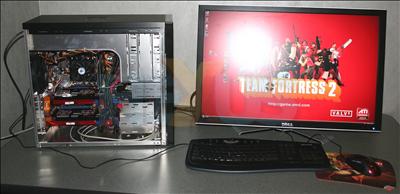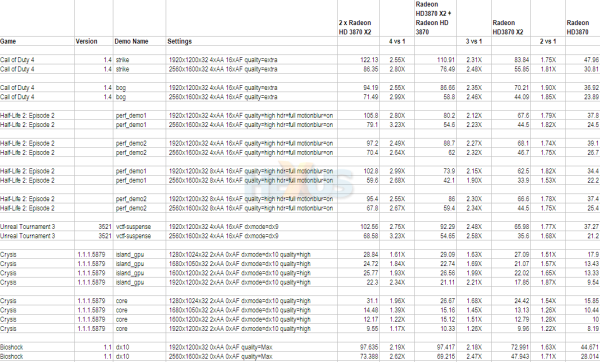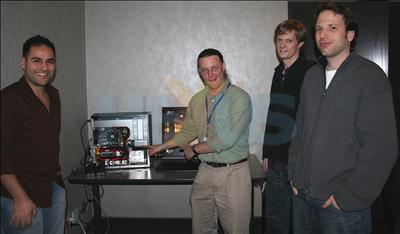The benchmark results from four-GPU CrossFireX
To demonstrate just where ATI is in terms of CrossFireX four-GPU performance and how well it scales, HEXUS was invited to a pre-release showing under AMD-controlled conditions at its base in Toronto, Canada.A four-GPU system, comprising of two Radeon HD 3870 X2s in CrossFireX, was already on display, as shown below.
An AMD quad-core Phenom 9900 (2.6GHz) CPU provided the grunt and an MSI 790FX motherboard the conduit to connect everything together.
We were told that the driver was two minor revisions from being passed fit for the CATALYST 8.3 release.
The premise here, ATI's representatives were eager to point out, was to show how CrossFireX performance scaled from a single Radeon HD 3870, through to a Radeon HD 3870 X2, then to an X2 with the single-GPU 3870, and, finally, with two 3870 X2s in tandem.
Effectively, that meant one-, two-, three-, and four-GPU performance, with the obvious caveat that frame-buffer and memory speeds were slightly different in each case.
Five games were benchmarked at 1,920x1,200 and 2,560x1,600 with high degrees of image quality, to put the onus on the graphics sub-system rather than the CPU.
The five games comprised of Call of Duty 4, Half-Life: Episode 2, Unreal Tournament 3, Crysis, and Bioshock.
HEXUS can confirm that the numbers on the spreadsheet below, provided by ATI (the graphics arm of AMD), do represent actual frame rates during testing, as we picked various benchmarks at random and they returned results within a minor standard deviation of what's shown below. Of course, we'll be doing our own testing once the driver is made available.
Click on the image to enlarge the spreadsheet screen-grab.
We already know that scaling from a single Radeon HD 3870 to an HD 3870 X2 can be near-2x for a number of games, and that observation is validated by the numbers in the 2-vs.-1 column, where 1.7x scaling is common.
Looking at the 3-vs.-1 column, represented by performance of a Radeon HD 3870 X2 and 3870 against a single 3870, scaling isn't quite as impressive but does hit >2x in all but Crysis.
Crysis suffers from two major problems with respect to multi-GPU scaling, as far as ATI is concerned. The engine doesn't lend itself well to queuing up the necessary frames and DX10 scaling is inherently poorer than DX9. These two factors combine to diminish the returns.
Looking at four-GPU scaling, as represented by two Radeon HD 3870 X2s in tandem, pushing 3x a single 3870's performance is highly dependent upon the title and resolution. Only Half-Life 2: Episode 2 manages it, just, with the other games scaling to around 2.5x. Crysis scaling, though, is horrendous, and that's a problem in itself, considering just how popular the game is.
Is there a need for such performance increases, you might ask? On a personal note, I run a Dell 3007WFP-HC monitor which ships with a 2,560x1,600 native resolution. I want to play the very latest games at the highest image-quality settings and at the WQXGA resolution. I therefore need scaling to work and work really well.
Summary
We've seen first-hand that CrossFireX, in its three- and four-GPU incarnation, works well enough in DX9 titles run at ultra-high resolutions and image-quality settings.A single-GPU Radeon HD 3870 is no slouch but performance can be up to 3x better with dual Radeon HD 3870 X2s. That will only really matter if you're playing fast-paced games and want all the eye candy turned on to maximum, however.
Scaling, though, is comparatively limited with the DX10 API, and Crysis - which is the most talked-about game of 2007 - gains are virtually non-existent at high resolutions.
Given what we've seen thus far, the optimum combination, assuming the underlying hardware is in place, appears to be a three-GPU graphics sub-system run at 1,920x1,200 and above. NVIDIA, we note, already has three-way SLI for its GeForce 8800 GTX and Ultra SKUs.
It's difficult to give firm buying advice with such a nascent technology. What we can say for now is that CrossFireX opens up new, flexible avenues for potential upgrades in the HD 3800-series family.
However, we reckon that the majority of popular gaming titles will need to scale to 3x before four-GPU operation becomes compelling enough to invest in.
Further analysis will be presented as we review the CrossFireX driver before its launch with the CATALYST 8.3 drivers.
Yup, Greg, four GPUs and two teraFLOPS in one box.
















